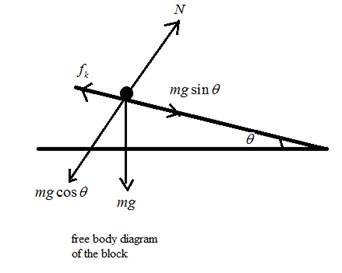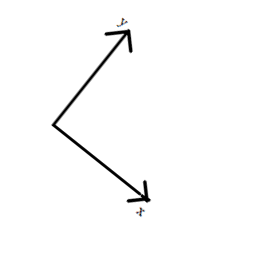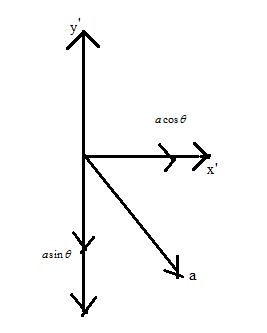
(a)
To calculate:
The block's position as a function of time for Oxy axes and the time taken by the block to reach the bottom.
Answer to Problem 1.1P
Position of the block in terms of (x,y) =
Time taken by the block to reach the ground
Explanation of Solution
Given:
A block of mass msliding down on an inclined plane making angle θ with respect to the horizontal surface.
Formula used:
Using equation of motion,
s = distance travelled by the block
u = initial velocity
t = time taken by the block
a = acceleration of the block
Calculation:


Forces on the block along x-axis,
Since the block is moving in x direction therefore, by the equation of motion.
m is the mass of the block
a is the acceleration of the block
by Newton's law of motion,
N = normal force
force of friction is given by
Put the value of N in equation (2)
Put the value of fxin equation (1)
By the equation of motion
Put the value of a from equation (3)
Since there is no motion in vertical direction,
Therefore, y =0
Time taken by the block to reach the ground.
Here, distance covered by the block is l.
Therefore, put
Conclusion:
Therefore, position of the block can be defined in
Time taken by the block to travel distance l,
(b)
To calculate:
The block's position as a function of time for Ox'y' axes and the time taken by the block to reach the bottom.
Answer to Problem 1.1P
Position of the block in terms of
Time taken by the block to reach the ground,
Explanation of Solution
Given:
A block of mass m sliding down on an inclined plane making angle θ with respect to the horizontal surface.
Formula used:
Using equation of motion,
s = distance travelled by the block
u = initial velocity
t = time taken by the block
a = acceleration of the block
Calculation:

Distance travelled in x-direction
Distance travelled in y direction
Position of the block in
Time taken by the block to reach the ground
Adding equation (1) and (2)
It is clear from the solution of part (a) and (b), that time taken by the box is same to travel the distance l.
Taking
Conclusion:
For
For
Want to see more full solutions like this?
Chapter 1 Solutions
Modern Physics For Scientists And Engineers
- Given vector A = <1, 10, 0> and vector B = <-10, 6, 0> , what is the angle between vectors A and B in degrees? Given vector A = <16, 12, -16> and vector B = <21, 24, -21> , what is the component magnitude of vector B in the direction of vector A? Given vector A = <23, -3, 3> and vector B = <0, 18, 15> , what is the magnitude of A x B? (Compute up to 4 decimal places)arrow_forward“An object is moving at a speed of v(t)= 3(t^2-1)+5tan (7t), where V is in m / s and t in seconds. What is your acceleration during the first two seconds? To answer this question, in mathematical terms, what are you asked to calculate an integral, a derivative, or a rate of change?arrow_forwardwrite the solution step by step and clearly.Answer Number 2.arrow_forward
- You take your pulse and observe 74 heartbeats in a minute. Whatare the period and frequency of your heartbeat?arrow_forwardIs equation E=VIt can be apply to question a.i? If yes then what is the explanation and what is the difference between each cases? If no then what is the correct formula and explanation to apply for?arrow_forwardI need help with Part E of this question, please.arrow_forward
- Please help me with this problem, and double check your answers, i have had many issues with tutors in the past giving incorrect answers, and thats of no use to me thenarrow_forwardShow that, when SI units for µ0 and ε0 are entered, the units given by the right-hand side of the equation in the problem above are m/s.arrow_forwardWhy was m converted to cm?arrow_forward
 Principles of Physics: A Calculus-Based TextPhysicsISBN:9781133104261Author:Raymond A. Serway, John W. JewettPublisher:Cengage Learning
Principles of Physics: A Calculus-Based TextPhysicsISBN:9781133104261Author:Raymond A. Serway, John W. JewettPublisher:Cengage Learning Classical Dynamics of Particles and SystemsPhysicsISBN:9780534408961Author:Stephen T. Thornton, Jerry B. MarionPublisher:Cengage Learning
Classical Dynamics of Particles and SystemsPhysicsISBN:9780534408961Author:Stephen T. Thornton, Jerry B. MarionPublisher:Cengage Learning

